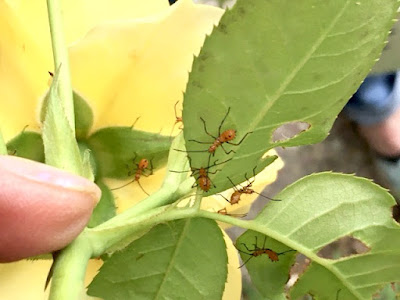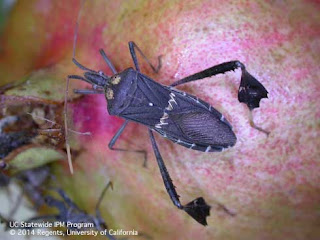
Leaf-footed bugs appear on roses, tomatoes and other juicy plants

|
|
These are leaf-footed bug nymphs. They tend to stay
in a pack when young. (Photo courtesy Alan Moritz)
|
“Good guys or bad guys?” That’s the question that accompanied this photo of mystery insects that suddenly appeared on a rose bush in a Sacramento garden.
Definitely bad guys – and they’re beginning to pop up all over town, especially on tomatoes, soft fruit and roses. The reason? They love triple-digit heat.
Those are nymphs (babies) of the leaf-footed bug, a relative of stink bugs. They'll make holes through your roses (and lots of other things). They’re very bad on tomatoes and can be a pest on apricots and peaches. They also like pomegranates, almonds, pistachios, citrus and watermelons.
Most of their damage is cosmetic, but in big numbers they can be a real nuisance. They puncture the fruit’s skin and suck out its juices.
The good news: They can't fly and they're slow. When young, they stick together. They release a pheromone that keeps the developing bugs in a little pack. (The better to attack your plants.)

|
|
Here's what leaf-footed bugs look like as adults.
(Photo courtesy UC IPM)
|
Like many stink bugs, they're resistant to any pesticides (unless it’s a direct hit). Because the young nymphs are wingless, their instinct is to jump down from wherever they’re dining and scramble for cover.
What to do? Under the plant, put a bucket or dishpan of water with a teaspoon of dish soap (to break the surface tension). Then, gently shake the bush, vine, branch or cane and knock the bugs into the water. (Often, they will just jump when they see your shadow.) They can't swim and they drown.
You also can blast the hell out of them with a hose (you’re watering the plants at the same time). Or you can just squish them, but wear gloves; they'll stain your hands (and they stink).
For more on leaf-footed bugs, check out these recommendations from the UC Cooperative Extension Pest Notes: http://ipm.ucanr.edu/PMG/PESTNOTES/pn74168.html
Comments
0 comments have been posted.Sacramento Digs Gardening to your inbox.
Sites We Like
Garden Checklist for week of May 5
Survey your garden after the May 4 rainstorm. Heavy rain and gusty winds can break the neck of large flowers such as roses. Also:
* Keep an eye on new transplants or seedlings; they could take a pounding from the rain.
* Watch out for powdery mildew. Warmth following moist conditions can cause this fungal disease to “bloom,” too. If you see a leaf that looks like it’s dusted with powdered sugar, snip it off.
* After the storm, start setting out tomato transplants, but wait on the peppers and eggplants (they want warmer nights). Pinch off any flowers on new transplants to make them concentrate on establishing roots instead of setting premature fruit.
* Trim dead flowers but not leaves from spring-flowering bulbs such as daffodils and tulips. Those leaves gather energy to create next year's flowers. Also, give the bulbs a fertilizer boost after bloom.
* Pinch chrysanthemums back to 12 inches for fall flowers. Cut old stems to the ground.
* Mulch around plants to conserve moisture and control weeds.
* From seed, plant beans, beets, cantaloupes, carrots, corn, cucumbers, melons, pumpkins, radishes and squash.
* Plant onion sets.
* In the flower garden, plant seeds for asters, cosmos, celosia, marigolds, salvia, sunflowers and zinnias. Transplant petunias, zinnias, geraniums and other summer bloomers.
* Plant perennials and dahlia tubers for summer bloom.
* Don’t wait; plant summer bulbs, such as gladiolus and tuberous begonias.
* Harvest cabbage, lettuce, peas and green onions.